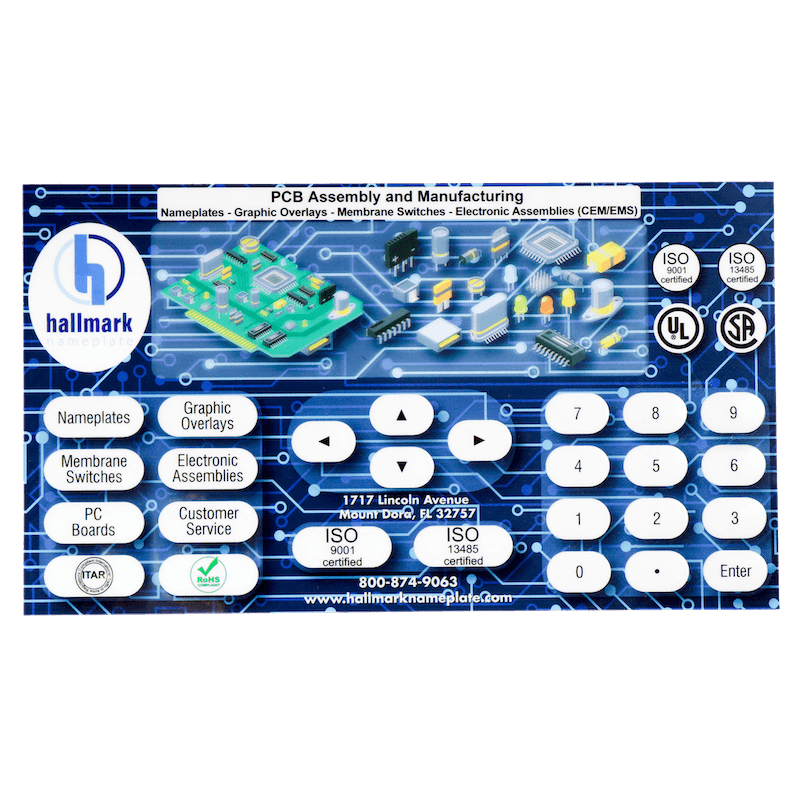Membrane Switch: Reliable, Cost-Effective, and User-Friendly Control Systems
Understanding Membrane Switches: The Key to Durable and Dependable Controls

What Are Membrane Layer Switches?
Membrane layer switches are an innovative solution in the realm of user interface technology, integrating capability and style flawlessly. These gadgets work as a user interface between individuals and digital systems, integrating numerous elements into a compact style. Usually built from flexible, thin layers of products, membrane layer switches are created to react to touch, allowing individuals to interact with machinery and electronic devices properly.
The main elements of a membrane switch include a printed circuit layer, graphic overlay, and a spacer layer that avoids unplanned activation. The graphic overlay can be tailored to reflect brand identification or customer preferences, boosting aesthetics while guaranteeing usability. Membrane buttons are frequently used in different applications, including medical tools, customer electronics, and commercial devices, owing to their longevity and resistance to ecological aspects such as wetness and dirt.
One of the crucial advantages of membrane switches is their capability to withstand deterioration, making them suitable for high-traffic environments. Additionally, they are light-weight and need minimal room, permitting ingenious designs in item advancement. Overall, membrane layer switches stand for a reliable and useful selection for contemporary digital interfaces, weding innovation with user-centric design concepts.
How Membrane Layer Switches Job
The procedure of membrane changes joints on a straightforward yet effective system that converts user input into digital signals. When a customer presses the button, the top layer warps, enabling a conductive component in the circuit layer to make call with a corresponding conductive pad on the underside of the visuals overlay.
The layout of membrane layer switches can vary, but they commonly include domes or responsive elements to offer comments to the individual, boosting the total experience - membrane switch. The products made use of in membrane switches, such as polyester or polycarbonate, contribute to their sturdiness and resistance to ecological variables, consisting of dampness and dirt. The printed circuits are usually enveloped, which secures them from wear and tear over time.
Benefits of Membrane Buttons

Furthermore, membrane layer buttons are recognized for their resilience. Built from robust materials, they are resistant to dust, wetness, and physical wear, which dramatically expands their life-span contrasted to traditional mechanical switches. This resilience makes them particularly suitable for high-traffic atmospheres and applications needing durability.
One more significant benefit is the ease of cleaning and upkeep. The smooth surface area of membrane changes reduces dust accumulation and is frequently impervious to spills, making them perfect for settings that require constant sanitization.
In addition, membrane layer buttons provide a streamlined profile, leading to a thinner layout that can be incorporated into various tools without including bulk. This feature not just improves the aesthetic appeal yet additionally contributes to a more ergonomic item style.
Applications of Membrane Buttons
User-friendly and versatile, membrane layer switches locate applications throughout a vast array of sectors, including clinical devices, consumer electronics, and industrial tools. In the medical field, these buttons Get More Information are important to gadgets such as analysis devices, patient surveillance systems, and infusion pumps, where integrity and simplicity of cleaning are essential. Their capability to withstand rough atmospheres and keep performance makes them perfect for such applications.

In consumer electronic devices, membrane layer switches are utilized in items like microwaves, washing makers, and remote controls - membrane switch. Their smooth layout allows for user-friendly interface, enhancing the general customer experience while providing toughness and resistance to tear and use
Commercial equipment likewise gains from membrane layer switches, especially in control panels for equipment and automation systems. These buttons offer protection against dirt and dampness, ensuring constant efficiency in difficult settings. Their personalized features allow manufacturers to tailor them to particular operational requirements, improving effectiveness and performance.
Selecting the Right Membrane Switch
When choosing a membrane switch, it is important to think about different elements that influence performance and viability for details applications. The key factors to consider include environmental conditions, responsive responses, toughness, and style specs.
First, evaluate the operating environment; buttons revealed to wetness, chemicals, or extreme temperature levels call for certain materials to ensure long life and performance. Next, evaluate the requirement for responsive feedback. Depending upon user interaction, some applications might profit from a tactile action to verify activation, while others may like a non-tactile style for aesthetic reasons.
Durability is an additional important element; membrane buttons ought to be designed to withstand constant usage, impacts, and abrasion. Guarantee the selected button can endure the anticipated lifecycle, especially in high-usage situations.

Conclusion
In verdict, membrane layer changes offer as important elements in the layout of reputable and sturdy control systems across different sectors. The versatility of membrane changes permits for tailored services that satisfy details operational needs, strengthening basics their value in modern technology.
Membrane changes stand for a critical aspect of modern interface style, mixing capability with strength in various applications.Membrane switches are a sophisticated service in the realm of individual interface innovation, integrating capability and style effortlessly. Usually built from adaptable, slim layers of products, membrane layer buttons are made to react to touch, enabling users to interact with machinery and digital tools effectively.
The layout of membrane layer buttons can differ, however see here now they commonly include domes or responsive aspects to offer feedback to the user, enhancing the total experience.In verdict, membrane layer changes serve as important components in the layout of sturdy and trusted control systems throughout different markets.